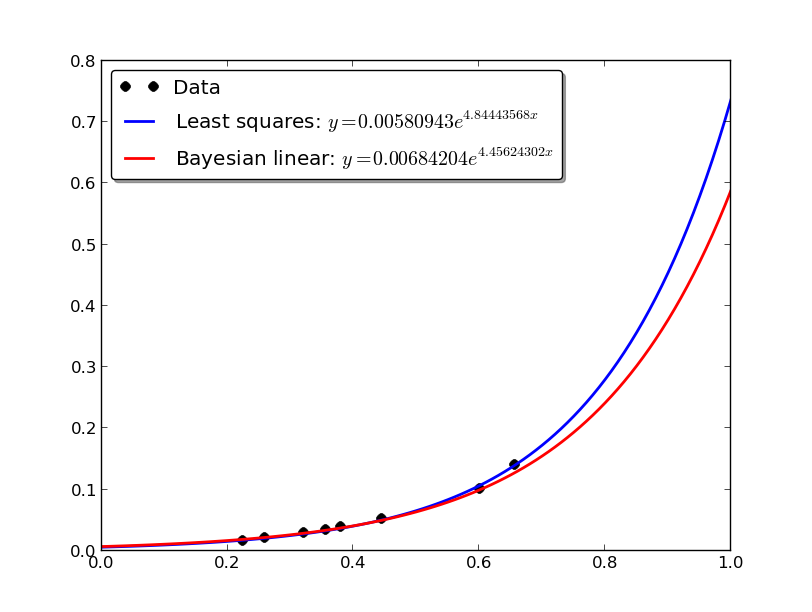- Published on
Python でベイズ線形回帰
- Authors

- Name
- Daisuke Kobayashi
- https://twitter.com
前回の最小二乗法に続き,ベイズ線形回帰で指数近似を行います.
理論的にはいろいろありますが,最終的な形は最小二乗法をちょっと変形するだけです.
ベイズ線形回帰の場合には,パラメータが 2 つあり 2 種を調整することでフィッティングの度合いを調整し,過学習を防ぐことができます.
#! /usr/bin/env python
# -*- coding: utf-8 -*-
import numpy
import matplotlib.pyplot as plt
def least_squares_regression(X, t, phi):
PHI = numpy.array([phi(x) for x in X])
w = numpy.linalg.solve(numpy.dot(PHI.T, PHI), numpy.dot(PHI.T, t))
return w
def bayesian_linear_regression(X, t, phi, alpha = 0.1, beta = 10.0):
PHI = numpy.array([phi(x) for x in X])
Sigma_N = numpy.linalg.inv(alpha * numpy.identity(PHI.shape[1]) + beta *
numpy.dot(PHI.T, PHI))
mu_N = beta * numpy.dot(Sigma_N, numpy.dot(PHI.T, t))
return mu_N
def exp_string(a, b):
return "$y = %0.8f e^{ %0.8f x}$" % (a, b)
if __name__ == '__main__':
X = numpy.array([6.559112404564946264e-01,
6.013845740818111185e-01,
4.449591514877473397e-01,
3.557250387126167923e-01,
3.798882550532960423e-01,
3.206955701106445344e-01,
2.600880460776140990e-01,
2.245379618606005157e-01])
t = numpy.array([1.397354195522357567e-01,
1.001406990711011247e-01,
5.173231204524778720e-02,
3.445520251689743879e-02,
3.801366557283047953e-02,
2.856782588754304408e-02,
2.036328213585812327e-02,
1.566228252276009869e-02])
phi = lambda x: [1, x]
w = least_squares_regression(X, numpy.log(t), phi)
mu_N = bayesian_linear_regression(X, numpy.log(t), phi)
lsq_a = numpy.exp(w[0])
lsq_b = w[1]
blr_a = numpy.exp(mu_N[0])
blr_b = mu_N[1]
fig = plt.figure()
ax = fig.add_subplot(1, 1, 1)
xlist = numpy.arange(0, 1.01, 0.01)
ax.plot(X, t, "ko", ms=7)
ax.plot(xlist, lsq_a * numpy.exp(lsq_b * xlist), "b-", lw=2)
ax.plot(xlist, blr_a * numpy.exp(blr_b * xlist), "r-", lw=2)
ax.legend(("Data",
"Least squares: " + exp_string(lsq_a, lsq_b),
"Bayesian linear: " + exp_string(blr_a, blr_b)),
loc="upper left", shadow=True, fancybox=True)
plt.show()
グラフを表示すると下記のようになります.全体的にデータ数が少ないですが,グラフを見ると,ベイズ線形回帰の方は x の値が大きい方でのフィッティング度合いが弱くなっています.データ数が疎であるため,ベイズ線形回帰では値を外れ値と見なし,過学習を防いでます.

参考: